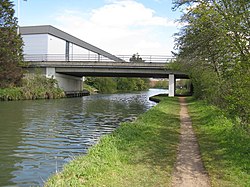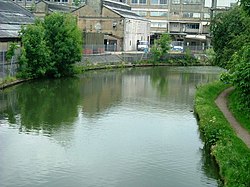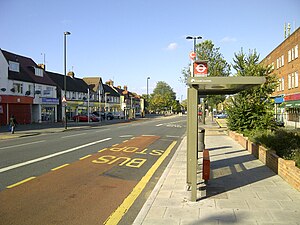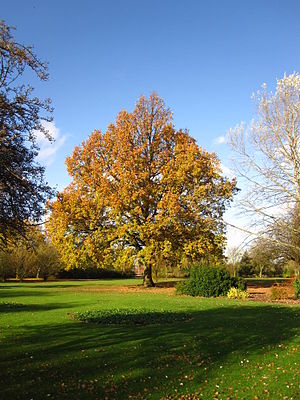Greenford
| Greenford | |
| Middlesex | |
|---|---|
 Grand Union Canal in Greenford | |
| Location | |
| Grid reference: | TQ135825 |
| Location: | 51°31’48"N, 0°21’46"W |
| Data | |
| Post town: | Greenford |
| Postcode: | UB6 |
| Dialling code: | 020 |
| Local Government | |
| Council: | Ealing |
| Parliamentary constituency: |
Ealing North |
Greenford is a town in Middlesex, located between Northolt to the west, Perivale to the east, Harrow to the north and Hanwell to the south.
Toponymy
The name is first recorded in 848 as Grenan forda. It is formed from the Old English 'grēne' and 'ford' and means 'place at the green ford'. Greenford was known as Great Greenford in order to distinguish it from Little Greenford, which is now known as Perivale. The affixes 'Magna' and 'Parva' have also been used to denote the difference.[1]
History
Industrial
Greenford is considered to be birthplace of the modern organic chemical industry, as it was at William Perkin's chemical factory in North Greenford, by the Grand Union Canal, that the world's first aniline dye was discovered in March 1856. Perkin called his amazing discovery 'mauveine'. Today there is a blue plaque marking the spot in Oldfield Lane North, just south of the Black Horse public house. Until 2013/14, Greenford was the home to the Hovis factory.[2] The former Rockware glassworks on the canal is commemorated by Rockware Avenue.
J. Lyons and Co.

Post First World War, tea blender and food manufacturer J. Lyons and Co. were looking for a secondary site on which to expand production beyond Cadby Hall, Hammersmith. In 1921 they bought the first piece of an eventual 63-acre site, due to its location close to good transport links from both the Grand Union Canal and the Great Western Railway's Great Western Main Line, and the West Coast Main Line and onwards to the Midlands at Willesden Junction.
The factory officially opened in July 1921, with the first single-storey buildings known as "Zig-Zag" due to their northern light-aligned windows allowing maximum light into the production area. There were steam and electrical power plants on site, which powered both the plant as well as the staff canteen and medical facilities, accessible to all plant employees and their dependants.[3] Transport docks and a canal basin had been developed, allowing shipment of tea and coffee directly from London Docks into HM Customs excise controlled bonded warehouses. The extensive onsite railway infrastructure allowed precise positioning of heavy raw goods into the factory, as well as the extraction of finished product. Lyons bought their own steam shunters to move wagons between the GWR exchange sidings and the factory system.[3]
Lyons quickly became Greenford's biggest employer. A later pioneer in electronic machines and computing, Lyons deployed the latest factory automation technology, making Greenford a showplace that was regularly visited by the media, academics, competitors and royalty, with more than one visit by King George V and Queen Mary. In the 1950s, the site developed the breakfast cereal Ready Brek.[3] Areas of the site not initially developed for factory use were landscaped, with many trees planted. As the factory developed these diminished, particularly after the development of the Lyons Maid Bridge Park factory in the 1950s, and the new administration block in 1971.[3]
After the merger of Lyons with Allied Bakeries in the 1980s, and the focus of the new Allied Domecq business to focus on spirits, with the sell-off of the businesses associated with the factory, the need for the facility dwindled. Redeveloped from 1998, today it is known as Lyon Way Industrial Estate.[3]
Art and culture
Five hundred yards north east from William Perkin's dye factory was a triangular field in which he kept horses. On this ground was built the Oldfield Tavern public house, which became a popular venue for a rock group called the Detours, who met a drummer there called Keith Moon. On Thursday 20 February 1964 they were introduced to the audience of the Oldfield Tavern as the Who.[4][5] (The tavern has not survived, however, and has since been replaced by a small block of flats and a petrol station). Andy Locke, Dave Kerr-Clemenson and Wal Scott were all in Edison Lighthouse, and with chart-topping Love Grows all came from Greenford.
Transport

The A40 Western Avenue, a major dual-carriageway, serves the area.
Tube
- Sudbury Hill station, on the Piccadilly line.
- Greenford station, on the Central line.

Rail
- Greenford station, on the Great Western line.
- South Greenford railway station, also on the Great Western line
Recreation
The grounds of the former Ravenor Farm has become Greenford's largest park. It is the venue for the annual Greenford Carnival, which is held every July.[6]
Until 1910, the land that formed Ravenor Farm/Ravenor Park was a detached part of Northolt parish, with the tithes to the land going to St Mary's Church, Northolt and not the Greenford parish of Holy Cross.
The former Ravenor Farm buildings in Oldfield Lane South are now home to the London Motorcycle Museum.
There are also the Northala hills near Northolt.
Sport & leisure
Greenford has two Non-League football teams London Tigers F.C. who play at the Avenue Park Stadium and North Greenford United F.C. who play at Berkeley Fields.
The trotting track at Greenford was a pioneer speedway venue and open meetings were staged 1928–1930. The track would be called a long track now, as it was of the order of half a mile/800 metres per lap. The trotting park was situated on what is now Birkbeck Avenue, just north of the A40 Western Avenue.
Places of interest
Greenford Heritage Centre: a cornucopia of British-made domestic paraphernalia of 20th century is on display - a variety of household items that were commonly found in British homes and gardens in the past.[7]
London Motorcycle Museum is the capital's only motorbike museum, opening in 1999 with a display of around 60 exhibits and now have around 200 exhibits on display including a wide range of bikes & memorabilia as well as knowledgeable staff.
Economy
Significant local businesses include: British Bakeries, IBM, Aurora (TV Lighting), Panavision, Panalux, Wincanton (Distribution Centre) and Royal Mail (Regional distribution centre). KBR has an office in Greenford.[8]
Notable people
- Sculptor C. J. Allen (1862–1956), a figure in the New Sculpture movement, was born in Greenford.
- Tennis player Blanche Bingley (1863–1946), six times women's singles champion at Wimbledon, was born in Greenford.
- Model Jourdan Dunn was born (1990) and brought up in Greenford.
- Pop singer Elyar Fox was brought up in Greenford.
- Comedian Freddie Frinton (1909–1968), who remains a household name in Germany and Scandinavia, lived in Greenford.
- Jack Good, pioneering music TV producer with links to artists including the Beatles and the Monkees, was born in Greenford.
- 19th century actor Charles Kean (1811–1868) grew up partly in Greenford.
- David Kerr-Clemenson - bass player with Edison Lighthouse, White Plains and Fast Buck - lived in Hedgerley Gardens, Greenford for twenty-two years.
- Singing sisters the Nolans attended the Cardinal Wiseman School in Greenford.
- Drummer Doug Sandom, Keith Moon's predecessor in rock band the Who, lives in Greenford.
- Lieutenant General Sir William Thornton (1779–1840), a leader of the Light Brigade, lived in Greenford.
- Jason Roberts, professional footballer, attended the Cardinal Wiseman School in Greenford.
- Steven Warner, eponymous star of The Little Prince, was born in Greenford.[9]
References
- ↑ Mills, D. (2000). Oxford Dictionary of London Place Names. Oxford.
- ↑ Bradbury, Poppy. "Hovis to close Greenford distribution centre". Get West London. http://www.getwestlondon.co.uk/news/local-news/hovis-close-greenford-distribution-centre-5972145. Retrieved 2015-12-24.
- ↑ 3.0 3.1 3.2 3.3 3.4 "The First Food Empire: A History of J.Lyons & Co". Peter Bird. http://kzwp.com/lyons/greenford.htm. Retrieved 2012-01-21.
- ↑ Joe McMichael, Jack Lyons (2004) The Who Concert File. Omnibus Press. ISBN 1-84449-009-2. Accessed 2010-06-25
- ↑ John Atkins (2000) The Who on record: a critical history, 1963-1998 McFarland, ISBN 0-7864-0609-7
- ↑ Ealing Council Greenford Carnival.
- ↑ Ealing Gazette (2008-09-19) http://www.ealinggazette.co.uk/lifestyle-ealing/listings-ealing/2008/09/19/what-s-on-at-greenford-64767-21857258/ What's on at Greenford.
- ↑ "Locations." KBR. Retrieved on 13 January 2008.
- ↑ "Most popular people born in Greenford". IMDb. http://www.imdb.com/search/name?birth_place=Greenford%2C+Middlesex%2C+England%2C+UK&. Retrieved 12 September 2014.